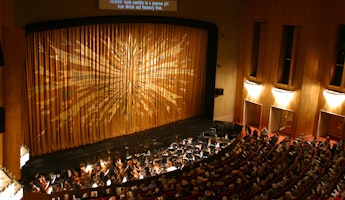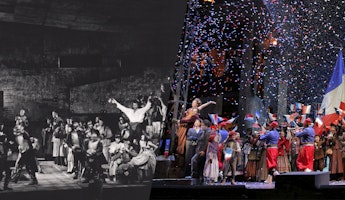Blog
September 21, 2022
A Prescription for Intrigue: "Lucia di Lammermoor"
In the company’s new production of Donizetti’s Lucia di Lammermoor, LA Opera explores the power of the art form to speak to today’s audience.
By Patrick D. McCoy
How often do we hear stories of our friends or loved ones "battling it out" with their own families? As the old adage goes, “the more things change, the more things remain the same.” It is always interesting how common day scenarios seem to play out as if they have never occurred before. That brings us to Donizetti’s great opera Lucia di Lammermoor. Composed at the height of his career, the story of Lucia is a prime example that there is "nothing new under the sun." Murder, lust and betrayal are all here in this opera and we are here for it!
This is an opera made for any modern-day talk show. Lucia is hell bent on giving in to her love for Edgardo, at the expense of her relationship with her family. As the plot thickens, so does the mayhem and violence, all leading up to the famous “mad scene," perhaps the most triggering focus in the opera. In this staging by Australian director Simon Stone, the very familiar story is reframed in present day America. Can you imagine that?
Take a moment to consider our own mad scenes in this country of late: the eye-opening murder of George Floyd, the COVID-19 pandemic, the Capitol insurrection and now, of all things, monkey pox! With all of this going on now in America, Stone adds another common day element to the mix by exploring the opioid crisis. As seen at the Metropolitan Opera earlier this year (where the Simon Stone co-production with LA Opera premiered), Lucia’s mad scene is set as the result of her being addicted to OxyContin. In a recent interview with Matt Dobkin surrounding the Met production, Stone discussed how it could be a relatable and believable explanation.
“Well, I didn’t want her to go mad just because she had to marry the wrong person. There is a series of steps at which a person has to be neglected by society before she is committed to an asylum. So essentially, I wanted to portray a more complex journey than just that she was made to choose between one of two men and being with the wrong one turned her into a psychopathic killer. The drug addiction does help with the mad scene, but more importantly, I want some people to think: 'Of course you ended up killing that guy. You’ve been subtly, casually abused on a daily basis by the men in your life.’”
I had the opportunity to discuss this provocative and exciting production with soprano Liv Redpath, who shares the role of Lucia with Amanda Woodbury in Los Angeles.
PM: The "stain" of Lucia's iniquity is perhaps best demonstrated in the traditionally blood-stained garment during the mad scene. Could you describe your process for channeling the contemporary idea of the mad scene into your interpretation of Lucia?
LR: My general impression of Lucia's "madness" is that of the canary in the coal mine—modernizing her story does little to change its meaning, but it does help an audience to relate more immediately to the ultimate lesson of her iniquity. I don't see Lucia as someone who is unwell, or rather, I don't see her as someone who has a preternatural bent to her eventuality. Like most humans, she does what she needs to survive. In Lucia's case, she manages the freewheeling and volatile emotions of the men surrounding her and the unfair gambles they make with her life. For her historical context, instead of showing the slightly bloodstained sheet of a virgin's broken hymen (which she may or may not be, having told her brother "ad altro giurai" ("I pledged to another"), she comes out, in Simon's world—as in any—covered in variable amounts of the blood of a man who, for all intents and purposes, she was given to as bargaining chip or piece of property. For this reason, in any context, I find Lucia's madness to be more about the catharsis of showing a sane young woman who has been forced into a corner of her life where the only options are societally condoned rape or total break from a reality that doesn't allow for basic human rights; cue canary in coal mine—if anything is off, it's the rest of them.
PM: Who are some of the Lucias that have inspired your performance of the role? What are some of the elements that you find rewarding, yet challenging about performing such an iconic role with a modern twist?
LR: For me, the power and grace of Lucia come most powerfully from Anna Moffo. Something about the rich and characterful quality of her singing and her expressive choices imbues the sound with someone I believe in. In this telling of Lucia, Simon's world helps me bring more of myself, since she is living in a world I have also lived and breathed in—it asks me to empathize with a part of America that we are all very aware has felt forgotten and overlooked, which is not lost on me.
PM: Our nation is currently experiencing its own series of mad scenes one after the other. How are you able to maintain the historic musical integrity of Lucia while using this interpretation to speak to a very contemporary issue?
LR: Opera's rich ability for vocal expression is timeless, and to employ it in new contexts is unbelievably clever—in a society where the natural human voice is used and heard less and less, to have the opportunity to take modern storytelling and layer on a visceral vocal form that allows for the widest human range of emotion and vulnerability is a brilliant way to bring humanity and empathy to the world we see in front of us.
It is always amazing when opera is given the opportunity to speak to the experiences of today’s audiences. This production of Lucia di Lammermoor certainly will give the audience the opportunity to challenge their own mad scenes, perhaps even escape from one through the awe and wonder of this new Los Angeles production.
Lucia di Lammermoor runs September 17 through October 9 at the Dorothy Chandler Pavilion.
Patrick D. McCoy distinguishes himself as a choral conductor, singer and music journalist. Juxtaposing a busy schedule between writing and public appearances, he has covered the arts for several outlets, including The Washington Post, Prince George’s Suite magazine, The Afro American Newspaper, Washington Classical Review, CBS Washington, Early Music America, Examiner.com and ArtSong Update, among others. Formerly the performing arts columnist for Washington Life magazine, he currently serves as organist/choirmaster at Saint John’s Episcopal Church in Beltsville, Maryland. He is a member of the Music Critics Association of North America, the National Association of Negro Musicians, Inc., the Association of Anglican Musicians and the Dean’s Circle of the Shenandoah Conservatory Advisory Board, a board member of the Haiti Micah Project and is a life member of Alpha Phi Alpha Fraternity, Inc. At Virginia State University in Petersburg, Virginia, he is the Interim Director of Choral Activities and Instructor of Voice.








/03-cosi/_dsc0996_pr.jpg?format=auto&fit=crop&w=345&h=200&auto=format)
















